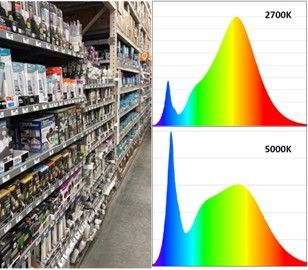Circadian Rhythm
Banned in the U.S: Healthy Light Bulbs
New DOE energy rules favor bright blue-pump LEDs and ignore health concerns.
Updated April 24, 2024 Reviewed by Hara Estroff Marano
Key points
- Driven by climate policy, the U.S. Department of Energy favors only blue-pump LED light bulbs after July 2028.
- DOE ignores the health benefits of the light spectrum and focuses only on cheap, bright, blue-rich light.
- Circadian-friendly lighting, which adds blue at day and removes blue at night, has lower lumens per watt.
- Lumens per watt measures the brightness of green and yellow wavelengths, not the blue and red tied to health.
In a retrograde move, the U.S. Department of Energy (DOE) has just issued a final rule that, effective June 25, 2028, will firmly cement the dominance of unhealthy blue-pump LED light bulbs. We must reverse this decision before it is too late.
There are so many misstatements and flawed analyses in the 110-page notice of April 19, 2024, in the Federal Register that it is hard to know where to begin. But here are some key extracts:
“DOE believes at this time that circadian-friendly integrated LED lamps do not possess unique attributes compared to other (GSLs).” (i.e. light bulbs, which they refer to as general service lamps). (p. 28877)
This is nonsense. Circadian-friendly light bulbs have distinct spectral power distributions—i.e., the relative amounts of light at each color wavelength. Circadian-friendly lights are rich in 480 nm blue during the day and emit minimal 480 nm blue in the evenings and at night. This can easily be measured with a handheld spectrophotometer.
Evidence establishes that circadian-friendly lights should be less than 2 percent 440-495 nm blue in the evening and at night, and more than 20 percent 440-495 nm blue during the daytime.
“There is no consensus on specific lamp attributes that meaningfully impact the human circadian cycle.” (p. 28877)
This statement ignores the literature of more than 10,000 peer-reviewed scientific papers since 2000 on the interaction of circadian clocks and light. It also fails to acknowledge multiple consensus reports and studies, such as the recent consensus study of 248 leading scientists who have published over 2,500 papers on circadian rhythms and light who concluded:
- The sensitivity peak of the ipRGC melanopic receptors in the human retina is approximately 480nm in the blue part of the visible spectrum.
- The most potent wavelengths for circadian entrainment are 460-495 nm blue light near to the sensitivity peak of the ipRGC melanopic receptors.
- Blue-enriched (460-495nm) light in the evening (during the three hours before bedtime) disrupts nocturnal sleep more than blue-depleted light at the same intensity.
- Blue-enriched (460-495nm) light in the evening (during the three hours before bedtime) phase delays the circadian system more than blue-depleted light at the same intensity.
- Blue-enriched (460-495nm) light in the evening (during the three hours before bedtime) disrupts circadian rhythms more than blue-depleted light at the same intensity.
- Exposure to 460-495nm blue light at night suppresses melatonin production.
- Exposure to 460-495nm blue light at night disrupts circadian rhythms.
- Light used in the evening (during the three hours before bedtime) should have as little blue content as practically possible.
- Increasing the energy efficiency of lights is desirable, but not if it increases the risks of causing circadian disruption and serious illness.
- LED lights with high 460-495nm blue content should carry the warning label: “may be harmful if used at night.”
In conclusion, light bulbs with high blue content have quite distinct and different attributes as compared with those that have low blue content.
“The adopted standards, which are expressed in minimum lumens (“lm”) output per watt (“W”) of a lamp or lamp efficacy (“lm/W”), ... These standards apply to all products .. manufactured in, or imported into, the United States starting on July 25, 2028.” (p. 28857)
DOE mistakenly regards lumens as the only value delivered by light bulbs and therefore focuses on maximizing lumens per watt (or minimizing the power necessary to create those lumens).
But lumens primarily measure the green and yellow wavelengths, which are associated with visual brightness. They do not measure the blue wavelengths critical for managing circadian health or the red wavelengths essential for healing.
Thus, electrical energy used to provide healthy light wavelengths is wasted energy, according to the DOE. As a consequence, healthy light bulbs are ranked lower when lumens per watt are used as the regulatory standard. This makes it extremely difficult, if not impossible, for healthy light bulbs to meet these arbitrary very high lumens/watt standards.
"DOE is not exempting circadian-friendly integrated LED lamps from the GSL definition in this final rule and as a result, these lamps will be subject to the standards for GSLs.” (p. 28877)
When the spectral distribution of light wavelengths has to be focused on reaching high lumens per watt targets, a large advantage is given to blue-pump LEDs. Not exempting circadian-friendly light bulbs from this new regulation, risks banning the use of low and zero-blue circadian-friendly light bulbs in the evening.
DOE is currently only monetizing health benefits from changes in ambient fine particulate matter (“PM 2.5”) concentrations from two precursors (SO 2 and NO X), and from changes in ambient ozone from one precursor (for NO X ) (p. 28859-60)
The DOE is tipping the scales to justify its draconian policy of banning healthy lights by taking into account only the benefits of reducing greenhouse gases. They fail to consider the health costs of using blue-rich LED light bulbs at night, which include sleep disorders, psychiatric disorders, obesity, diabetes, heart disease, breast cancer, prostate cancer, colorectal cancer, and much more.

What Happened?
As the DOE acknowledged:
“In the January 2023 provisional rules, DOE proposed a definition for 'circadian-friendly integrated LED lamps' and proposed that lamps meeting that definition be excluded from the GSL definition. DOE identified commercially available integrated LED lamps that are marketed as aiding in the human sleep-wake ( i.e., circadian) cycle by changing the light spectrum and also observed that their efficacies ranged from 47.8 lm/W to 85.7 lm/W.”
However, the lighting industry and climate lobbies urged the DOE to cancel the proposed exemption, arguing that it was a loophole that lighting manufacturers might use to circumvent the regulatory standard.
Unfortunately, the DOE ignored the evidence provided by me and others about how essential it is to protect the health advantages of using spectral-engineered, circadian-friendly light to protect our health.
To save the health of all users of light, this harmful and ill-formed decision by the DOE must be reversed before circadian-friendly light bulbs disappear from store shelves in 2028.
References
US Department of Energy (2024) Energy Conservation Program: Energy Conservation Standards for General Service Lamps: Final Rule, Federal Register / Vol. 89, No. 77 / Friday, April 19, 2024 / Rules and Regulations pages 28856-28965)
Moore-Ede M. (2024) THE LIGHT DOCTOR: Using Light to Boost Health, Improve Sleep, and Live Longer. CIRCADIAN Books www.thelightdoctor.com
Moore-Ede M. et al (2023) Lights should support circadian rhythms: evidence-based scientific consensus. Front. Photon 4: https://doi.org/10.3389/fphot.2023.1272934




